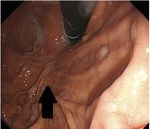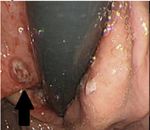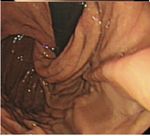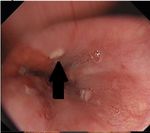The Outcome of Endoscopic Radiofrequency Anti-Reflux Therapy (STRETTA) for Gastroesophageal Reflux Disease in Patients with Previous Gastric ...
←
→
Page content transcription
If your browser does not render page correctly, please read the page content below
ORIGINAL ARTICLE
Clin Endosc 2021;54:542-547
https://doi.org/10.5946/ce.2020.243
Print ISSN 2234-2400 • On-line ISSN 2234-2443
Open Access
The Outcome of Endoscopic Radiofrequency Anti-Reflux Therapy
(STRETTA) for Gastroesophageal Reflux Disease in Patients with
Previous Gastric Surgery: A Prospective Cohort Study
Edward John Nevins, James Edward Dixon and Yirupaiahgari Krishnaiah Setty Viswanath
Department of Upper GI surgery, James Cook University Hospital, South Tees Hospitals NHS Foundation Trust, Middlesbrough, UK
Background/Aims: STRETTA improves the quality of life and reduces the need for anti-reflux medication in select patients,
especially those with uncomplicated gastroesophageal reflux disease (GERD). We aimed to review the outcomes of STRETTA in
patients with medically refractory GERD, who had undergone previous gastric surgery.
Methods: This was a review of a prospective database in a British center. Since 2016, all GERD patients who underwent STRETTA
and had a history of previous gastric surgery were studied (n=11). Anti-reflux medication pre- and post-STRETTA was evaluated.
The outcomes were assessed objectively by the change in anti-reflux medication and subjectively through a pre- and post-procedure
GERD-health-related quality of life (HRQL) questionnaire.
Results: The median length of follow-up was 23 months. Nine patients demonstrated improved GERD-HRQL scores
following STRETTA (82%). Of the 7 patients who underwent fundoplication, all reported improved symptoms, with 3 patients
discontinuing the medication and 3 patients on a reduced dose of proton pump inhibitor. Four patients underwent surgery other
than fundoplication, of which 2 reported improvement and discontinued the proton pump inhibitor. Two patients reported no
improvement.
Conclusions: This study demonstrates that STRETTA is successful in reducing refractory GERD in patients with previous gastric
surgery. The outcomes were comparable to published outcomes in patients with uncomplicated GERD with no previous history of
gastric surgery. Clin Endosc 2021;54:542-547
Key Words: Endoscopic management; Gastro-esophageal reflux disease; Revisional anti-reflux procedure; STRETTA
INTRODUCTION for Health and Care Excellence (NICE) for cases refractory to
medical therapy.2
Endoscopic radiofrequency therapy for gastroesophageal STRETTA improves the quality of life and reduces the need
reflux disease (GERD) has been proven to be successful.1 for anti-reflux medication in a select group of patients,3 name-
STRETTA is the only radiofrequency device licensed for this ly those with uncomplicated GERD. Complicated GERD is de-
indication in the UK and is approved by The National Institute fined as the presence of stenotic disease, ulcerative esophagitis,
scarring of the gastro-esophageal junction (GEJ), a recurrent
hiatus hernia of > 2.5 cm, a dilated crura of > 2.5 cm, Barrett’s
Received: September 4, 2020 Revised: November 25, 2020 metaplasia, wrap migration, and gastric volvulus.4 At our cen-
Accepted: November 30, 2020
ter, STRETTA is not performed on patients with complicated
Correspondence: James Edward Dixon
Department of Upper GI Surgery, South Tees Hospitals NHS Foundation Trust, GERD. STRETTA has also been shown to be cost-effective in
James Cook University Hospital, Marton Road, Middlesbrough, Cleveland TS4 some studies.5
3BW, UK
Tel: +44-16-4285-0850, E-mail: james.dixon5@nhs.net For refractory GERD in patients with a history of previous
ORCID: https://orcid.org/0000-0001-7860-710X gastric surgery, STRETTA is effective; however, it has been
This is an Open Access article distributed under the terms of the Creative reported only in a few studies. A retrospective study of 6 pa-
Commons Attribution Non-Commercial License (http://creativecommons.org/
licenses/by-nc/3.0) which permits unrestricted non-commercial use, distribution, tients with a history of previous Roux-en-Y gastric bypass
and reproduction in any medium, provided the original work is properly cited. showed that STRETTA led to resolution of the symptoms in
542 Copyright © 2021 Korean Society of Gastrointestinal EndoscopyNevins EJ et al. STRETTA for Reflux Following Gastric Surgery
5 patients.6 Two prospective studies with a small sample size Due to the waiting period in the National Health Service,
that reviewed STRETTA following anti-reflux surgery demon- the time from this appointment to the actual procedure was
strated good outcomes in patients with treatment-refractory variable. However, all patients were screened on the day of the
GERD; 15/18 patients had improved outcomes,7 and 6/7 pa- procedure to confirm that the ongoing symptoms persisted.
tients were satisfied with the results.8 The post-procedure GERD-HRQL was administered at the
We aimed to review the outcomes of STRETTA at a spe- post-procedure follow-up appointment, between 4 and 12
cialist center in patients who had undergone previous gastric weeks after the procedure. The overall length of follow-up was
surgery and had GERD refractory to medication. This case determined by the time since the procedure as the medications
series will add to the limited evidence for the use of STRETTA post-procedure were reviewed on the same date, April 29,
in patients with a history of gastric surgery, having GERD re- 2020 (follow-up range, 2–42 months). A local ethics commit-
fractory to medication. tee approved the maintenance of the prospective database, and
patients provided written consent for the treatment and study.
The indications for STRETTA in our center are in confor-
MATERIALS AND METHODS mity with the NICE guideline according to which, if proton
pump inhibitor (PPI) medication has failed to resolve the
This was a review of a prospectively maintained database symptoms, endoscopic radiofrequency therapy may be used
at a tertiary referral center in the UK. In all, 196 patients before or after the surgery.3
underwent STRETTA since 2016. Of these, 11 patients who
had undergone previous gastric surgery were identified. All
patients were assessed by pre-operative endoscopy, 24-hour RESULTS
pH and manometry, and barium studies. Demographic data
such as age, sex, and history of previous surgery were re- Eleven patients were included in the case series. The medi-
corded in a prospectively maintained database. Anti-reflux an follow-up duration was 23 months (range, 2–42 months).
medication before and after STRETTA were reviewed. The Nine patients demonstrated improved GERD-HRQL scores
reported outcome of STRETTA was assessed objectively by following STRETTA (82%) (Fig. 1). Of these, 3 patients re-
the change in anti-reflux medication post-procedure and quired no further anti-reflux medication. Before STRETTA, all
subjectively through a pre- and post-procedure questionnaire. 11 patients were taking a PPI. After the procedure, 5 of them
The questionnaire used was the GERD-health-related quality were able to discontinue the PPI altogether, and 3 patients had
of life (GERD-HRQL), which has been validated for assess- a reduced dose of PPI.
ing the severity of GERD.9 The pre-procedure GERD-HRQL Fundoplication was the most common intervention (Table
was administered at the pre-procedure clinic appointment. 1). Of the 7 patients who had undergone a previous fundo-
Positive
LNF Outcome
n=7 n=7
Total
Patients Vagotomy+
n=11 Pyloroplasty Positive
Outcome
Other Fundal GIST n=2
Gastric Resection
Surgery
n=4
Roux-en-Y
Bypass Negative
Outcome
n=2
Esophyx
Fig. 1. Flowchart of the outcomes following STRETTA. GIST, gastrointestinal stromal tumor; LNF, laparoscopic Nissen fundoplication.
543plication, all reported an improvement in symptoms (100%), are shown in Figs. 2C and 2D.
with 3 patients discontinuing the medication completely (43%) One patient, with a history of an Esophyx or transoral inci-
and 3 patients on a reduced dose of PPI (43%). Only 1 patient sionless fundoplication (TIF), was only on PPI before STRET-
with a history of fundoplication did not discontinue or reduce TA; however, following the procedure is on PPI and an antac-
the PPI usage following STRETTA; however, the H2-receptor id. The endoscopic images of this patient are shown in Fig. 2E,
antagonist (H2RA) was no longer required. Endoscopic imag- F. This patient underwent 2 additional revisional anti-reflux
es before and after the procedure of a patient with a history of surgeries after EsophyX. Biopsies showed benign esophageal
previous fundoplication are demonstrated in Figs. 2A and 2B. inflammatory changes without Barrett’s esophagus.
Four patients underwent gastric interventions other than A patient with a history of gastric bypass, who showed no
fundoplication (Table 2). Two of these patients reported an improvement on the subjective scoring system, now requires
improvement (50%). Of these, 1 patient with a history of vag- only a PPI on a PRN (pro re nata) basis, although he required
otomy and pyloroplasty discontinued the PPI altogether, and regular PPI and antacids before the procedure.
is now only on an antacid. The other patient, with a history of The time from original gastric surgery to STRETTA varied
resection for a fundal gastrointestinal stromal tumor (GIST), from 2 years to 40 years. There was no link between the time
reported an excellent outcome, with a significant improve- since surgery and outcomes following STRETTA.
ment in symptoms. The endoscopic images of these patients
Table 1. Patients Who Had Undergone Previous Fundoplication and Their Results following STRETTA
Date of Follow-up Reported
Patient Age Sex Pre STRETTA meds Post STRETTA meds
STRETTA (mo) outcome
1 2016 57 M 42 PPI + Antacid Reduced PPI dose, antacid stopped Improved
2 2016 66 F 40 PPI No medication dependence Improved
3 2017 66 M 39 PPI Reduced PPI dose Improved
4 2018 44 M 23 PPI + Antacid + H2RA Reduced PPI dose, antacid and H2RA stopped Improved
5 2018 66 F 16 PPI + Antacid No medication dependence Improved
6 2019 62 F 7 PPI + Antacid + H2RA No medication dependence Improved
7 2020 54 F 4 PPI + Antacid + H2RA PPI and Antacid the same, H2RA stopped Slightly improved
H2RA, H2-receptor antagonist; PPI, proton pump inhibitor.
Table 2. Patients with a History of Previous Gastric Surgery Other than Fundoplication and Their Results following STRETTA
Date of Follow up Pre STRETTA Reported
Patient Previous surgery Age Sex Post STRETTA meds
STRETTA (mo) meds outcome
1 Esophyx and two further 2017 64 M 30 PPI Ongoing PPI usage with No Improve-
revisional antireflux surgeries antacid ment
2 Fundal GIST resection 2017 68 F 30 PPI + Antacid PPI stopped Improved
Now taking H2RA + antacid
3 Roux-en-Y gastric bypass 2018 70 F 16 PPI + Antacid Ongoing PPI, antacid No improve-
stopped ment
4 Vagotomy and pyloroplasty 2018 67 M 16 PPI + Antacid PPI stopped Improved
Ongoing antacid
GIST, gastrointestinal stromal tumor; H2RA, H2-receptor antagonist; PPI, proton pump inhibitor.
544Nevins EJ et al. STRETTA for Reflux Following Gastric Surgery
Procedure Pre-STRETTA endoscopic appearance Post-STRETTA endoscopic appearance
Previous
fundoplication
A B
Spherical thermal lesions following
STRETTA (arrow)
Loose wrap with the preserved angle of His,
and a lax GEJ, with refluxing gastric
contents (arrow)
Resection of
C D
Fundal GIST
with fundus
scarring
Fundal scar (arrow) Spherical thermal lesions following
STRETTA (arrow)
Esophyx and E F
two further
revisional
antireflux
surgeries
Esophyx fastener at GEJ (arrow), Ongoing prolapse of gastric mucosa, which
maintained angle of His, with laxity of GEJ, may explain the patients’ failure to improve.
and prolapse of the gastric mucosa Spherical thermal lesions (arrow)
Fig. 2. Endoscopic images pre- and post-STRETTA. GEJ, gastro-esophageal junction; GIST, gastrointestinal stromal tumor.
545DISCUSSION gastric bypass obliterates the angle of His, which normally pre-
vents reflux of bile into the esophagus.6 Although STRETTA is
Symptoms of GERD are common in patients who have postulated to stimulate muscular hypertrophy, increasing the
undergone previous gastric surgery. This might be due to tone of the lower esophageal sphincter,2 it does not affect the
non-resolution of the symptoms following an attempt at an- angle of His. In the present study, we had a single patient with
ti-reflux surgery or as a direct result of the procedure itself, persistent symptoms following STRETTA after Roux-en-Y
such as in Roux-en-Y gastric bypass.6 In patients with no gastric bypass, although the medication requirements had
history of previous gastric surgery, STRETTA has shown a decreased. However, in a study on outcomes of STRETTA fol-
reduction in the dependence on PPI. However, in most pa- lowing laparoscopic Roux-en-Y gastric bypass, 83% of the pa-
tients, PPI cannot be completely discontinued.10 Considering tients had complete resolution of symptoms. The sample size
PPI usage as a measure of success of STRETTA, only 73% of was small (n= 6); however, the patients were followed up for a
the patients in this series could discontinue or reduce PPI. A mean of 20 months, by which time 5 patients were asymptom-
previous study that evaluated STRETTA in patients with no astic.6 Further research on STRETTA following gastric bypass
previous gastric surgery reported that 78% of patients could surgery is necessary with larger sample size.
discontinue or reduce PPI.10 This suggests that patients who Only one patient in our data set had undergone a previous
have undergone previous gastric interventions might have TIF or EsophyX, a novel alternative anti-reflux endoscopic
outcomes comparable to those who did not. procedure. The patient reported no improvement and re-
Laparoscopic Nissen fundoplication (LNF) has been con- quired additional anti-reflux medication post-procedure. Eso-
sidered as the gold standard intervention for GERD resistant phyX is effective in managing GERD. In a study that followed
to optimal medical therapy. However, it has been reported patients for 6 years following EsophyX, 86% of the patients
that 21% of the patients after LNF will have ongoing GERD required a reduced dose of PPI, and around 50% of them had
symptoms requiring medication, and 17% will require revi- discontinued the PPI completely.14 In TIF, the stomach, and
sional surgery.11 These patients face the prospect of lifelong distal esophagus are pulled together into a roll to form a valve
dependence on medication or a second surgery. Revisional at the lower esophageal sphincter, held in place by multiple
Nissen fundoplication is associated with a lower probability polypropylene fasteners.15 These fasteners might disrupt the
of success and a greater risk of morbidity.7 Alternatively, long- delivery of energy during STRETTA, which might be respon-
term anti-reflux medication usage is associated with a high sible for the failure of STRETTA in this patient.
cost and long-term risks such as infectious complications, car- The small sample size is a limitation of this case series. Nev-
diac complications, and nutritional problems.12 STRETTA is ertheless, though STRETTA is not routinely used for recurrent
proven to be more cost-effective than surgical management.13 or primary GERD after gastric surgery, we believe this is the
A study involving 7 patients with persistent reflux after an- second-largest cohort of patients on this topic.7 An addition-
ti-reflux surgery, showing that 85.7% of the patients were sat- al limitation is the lack of post-operative pH or manometry
isfied with the result following STRETTA.8 In the present case studies to help establish reasons for the success or failure of the
series, similar results were achieved. 100% of the patients who STRETTA procedure. These tests are not routinely performed
underwent fundoplication could discontinue or reduce the postoperatively at our center. This is an initial study that
PPI medication following STRETTA. Overall, patients with demonstrates that STRETTA is safe and likely to be beneficial
failed previous Nissen fundoplication are likely to have a sig- in this cohort; however, further research is necessary to predict
nificant benefit from STRETTA as they can potentially reduce treatment success. This includes correlation with additional
or discontinue PPI medications and can avoid a revisional measures for GERD-HRQL, such as symptom index or symp-
surgery, which has a higher risk. We have demonstrated good tom association probability.16
outcomes in patients who have undergone previous fundopli- In summary, this case series demonstrates that STRETTA
cation, and therefore STRETTA might augment the neo-GEJ is successful in reducing refractory GERD in patients with a
following fundoplication. history of gastric surgery. The outcomes in this cohort of pa-
Clinicians should remember changes in the gastric anatomy, tients were comparable to published outcomes in patients with
and therefore physiology following gastric surgery might be uncomplicated GERD who have not previously undergone a
the reason for the failure of STRETTA in these patients. For gastric intervention.
example, in patients who have undergone Roux-en-Y gastric
bypass or pyloroplasty, GERD symptoms are likely to be due to Conflicts of Interest
bile reflux following changes in the anatomy of the distal stom- The authors have no potential conflicts of interest.
ach. Furthermore, the formation of the gastric tube during a
546Nevins EJ et al. STRETTA for Reflux Following Gastric Surgery
Funding Long-term cost-effectiveness of medical, endoscopic and surgical man-
None. agement of gastroesophageal reflux disease. Surgery 2015;157:126-136.
6. Mattar SG, Qureshi F, Taylor D, Schauer PR. Treatment of refractory
gastroesophageal reflux disease with radiofrequency energy (Stretta) in
Author Contributions patients after Roux-en-Y gastric bypass. Surg Endosc 2006;20:850-854.
Conceptualization: Edward John Nevins, Yirupaiahgari Krishnaiah Setty 7. Noar M, Squires P, Khan S. Radiofrequency energy delivery to the lower
Viswanath esophageal sphincter improves gastroesophageal reflux patient-reported
Supervision: YKSV outcomes in failed laparoscopic Nissen fundoplication cohort. Surg En-
Writing-original draft: James Edward Dixon dosc 2017;31:2854-2862.
Writing-review&editing: EJN, JED, YKSV 8. McClusky DA, 3rd, Khaitan L, Swafford VA, Smith CD. Radiofrequency
energy delivery to the lower esophageal sphincter (Stretta procedure)
ORCID in patients with recurrent reflux after antireflux surgery: can surgery be
avoided? Surg Endosc 2007;21:1207-1211.
Edward John Nevins: https://orcid.org/0000-0002-4172-3729
9. Velanovich V. The development of the GERD-HRQL symptom severity
James Edward Dixon: https://orcid.org/0000-0001-7860-710X
instrument. Dis Esophagus 2007;20:130-134.
Yirupaiahgari Krishnaiah Setty Viswanath: https://orcid.org/0000-0003-3880-1172
10. Coron E, Sebille V, Cadiot G, et al. Clinical trial: radiofrequency energy
delivery in proton pump inhibitor-dependent gastro-oesophageal reflux
disease patients. Aliment Pharmacol Ther 2008;28:1147-1158.
REFERENCES 11. Kelly JJ, Watson DI, Chin KF, Devitt PG, Game PA, Jamieson GG. Lapa-
roscopic Nissen fundoplication: clinical outcomes at 10 years. J Am Coll
Surg 2007;205:570-575.
1. He S, Xu F, Xiong X, et al. Stretta procedure versus proton pump inhibi- 12. Shah NH, LePendu P, Bauer-Mehren A, et al. Proton pump inhibitor
tors for the treatment of nonerosive reflux disease: a 6-month follow-up. usage and the risk of myocardial infarction in the general population.
Medicine (Baltimore) 2020;99:e18610. PLoS One 2015;10:e0124653.
2. National Institute for Health and Care Excellence. Stretta system for gas- 13. Gregory D, Scotti DJ, Buck D, Triadafilopoulos G. Budget impact analy-
tro-oesophageal reflux disease [Internet]. London: NICE; c2016 [updat- sis to estimate the cost dynamics of treating refractory gastroesophageal
ed 2016 Jul 26]. Available from: https://www.nice.org.uk/advice/mib74. reflux disease with radiofrequency energy: a payer perspective. Manag
3. Viswanath Y, Maguire N, Obuobi RB, Dhar A, Punnoose S. Endoscopic Care 2016;25:42-50.
day case antireflux radiofrequency (Stretta) therapy improves quality 14. Testoni PA, Testoni S, Mazzoleni G, Vailati C, Passaretti S. Long-term ef-
of life and reduce proton pump inhibitor (PPI) dependency in patients ficacy of transoral incisionless fundoplication with Esophyx (Tif 2.0) and
with gastro-oesophageal reflux disease: a prospective study from a UK factors affecting outcomes in GERD patients followed for up to 6 years:
tertiary centre. Frontline Gastroenterol 2019;10:113-119. a prospective single-center study. Surg Endosc 2015;29:2770-2780.
4. Viswanath YKS. Endoscopic prudence to assess gastro-esophageal 15. Testoni PA, Mazzoleni G, Testoni SG. Transoral incisionless fundopli-
junction (GEJ); a necessity rather a prerequisite prior to endoscopic an- cation for gastro-esophageal reflux disease: Techniques and outcomes.
ti-reflux treatment in gastro-esophageal reflux disease (GERD) patients. World J Gastrointest Pharmacol Ther 2016;7:179-189.
Acta Scientific Gastrointestinal Disorders 2020;3:29-31. 16. Vaezi MF. Use of symptom indices in the management of GERD. Gas-
5. Funk LM, Zhang JY, Drosdeck JM, Melvin WS, Walker JP, Perry KA. troenterol Hepatol (N Y) 2012;8:185-187.
547You can also read



























































